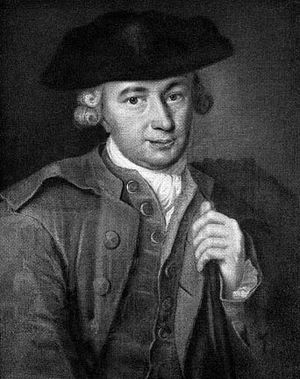Johann Georg Hamann facts for kids
Quick facts for kids
Johann Georg Hamann
|
|
|---|---|
 |
|
| Born | 27 August 1730 |
| Died | 21 June 1788 (aged 57) Münster, Prince-Bishopric of Münster
|
| Alma mater | University of Königsberg (1746–1751/52; no degree) |
| Era | 18th-century philosophy |
| Region | Western philosophy |
| School | Post-Kantian Counter-Enlightenment Sturm und Drang |
|
Main interests
|
Philosophy of language, epistemology, philosophy of mind, aesthetics, philosophy of history, political philosophy |
|
Notable ideas
|
"Reason is language" ("Vernunft ist Sprache") |
|
Influences
|
|
|
Influenced
|
|
Johann Georg Hamann (born August 27, 1730 – died June 21, 1788) was an important German philosopher. He came from Königsberg and was sometimes called "the Wizard of the North." He was a key figure in philosophy after Immanuel Kant.
Hamann's ideas helped start the Sturm und Drang movement. This was a time in German art and literature that focused on strong emotions. He is also linked to the Counter-Enlightenment and Romanticism. These movements questioned the idea that only reason could lead to truth.
Hamann introduced his friend Kant to the ideas of David Hume and Jean-Jacques Rousseau. Hume's work helped Kant think differently about philosophy. Even though Hamann was influenced by Hume, he used these ideas to support Christianity.
Famous thinkers like Johann Wolfgang von Goethe and Søren Kierkegaard thought Hamann was one of the smartest people of his time. He also greatly influenced G. W. F. Hegel and Friedrich Jacobi. Hamann believed that understanding language was more important than just studying how we gain knowledge.
Contents
Early Life and Learning
Johann Georg Hamann was born in Königsberg on August 27, 1730. Today, Königsberg is called Kaliningrad and is in Russia. He first studied theology at the University of Königsberg.
After his studies, he worked as a clerk for a trading company. He also held several small government jobs. In his free time, he loved to read and study philosophy. His first published work was about money and trade. He used the pen name "the Magus of the North."
Hamann believed in the ideas of the Enlightenment for a while. The Enlightenment was a period that emphasized reason and science. But after a special experience in London in 1758, his views changed.
Many experts believe that Hamann's German translation of David Hume's work was very important. His friend Immanuel Kant said this translation "woke him from his dogmatic slumber." This means it made Kant think deeply about his own beliefs. Hamann and Kant respected each other. Hamann also introduced Kant to the writings of Rousseau.
A Love for Music
Hamann was also a talented musician. He played the lute, which is a stringed instrument. He learned to play from Timofey Belogradsky. Belogradsky was a skilled Ukrainian musician living in Königsberg at the time.
Hamann's Main Ideas
Hamann did not fully trust the idea that reason alone could solve all problems. He once joked, "I look upon logical proofs the way a well-bred girl looks upon a love letter." He believed that faith in God was the best way to understand difficult philosophical questions.
He thought that Immanuel Kant saw reason as something separate from people. But Hamann believed reason was connected to our bodies and experiences. Hamann was very influenced by David Hume. This led Hamann to believe that faith and belief, not just knowledge, guide what people do. He also thought that an idea's power comes from the habits it reflects, not just from the idea itself.
His Writings
Hamann's writings were usually short essays. They were much shorter than the works of other thinkers of his time. His essays also used many different references and long comparisons. He often wrote in response to other people's ideas. For example, his work Golgotha and Scheblimini! was written against Moses Mendelssohn's book about religion.
Hamann famously used the example of Socrates in his essay Socratic Memorabilia. Socrates often said he knew nothing. Hamann used this to criticize the Enlightenment's strong focus on reason. In another work, Aesthetica in nuce, Hamann argued that feeling and artistic experience were very important. He also highlighted the role of genius in understanding nature.
Reason is Language
One of Hamann's most important ideas was about language. He famously said, "Reason is language" (Vernunft ist Sprache). He believed that language connects our inner thoughts with the world we see. This idea was very new for his time. It is seen as an early step towards the idea that language shapes how we think. This idea later became important in philosophy, especially for thinkers like Ludwig Wittgenstein.
Hamann's Lasting Impact
Hamann was a major force behind the Counter-Enlightenment. This movement questioned the main ideas of the Enlightenment. He was also a teacher to Johann Gottfried Herder. Many famous people admired Hamann, including Goethe, Friedrich Heinrich Jacobi, Georg Wilhelm Friedrich Hegel, Søren Kierkegaard, Gotthold Ephraim Lessing, and Moses Mendelssohn.
More recently, Hamann's ideas have influenced modern religious thinkers. These include Oswald Bayer, John Milbank, and David Bentley Hart. The philosopher Charles Taylor also credits Hamann, along with Wilhelm von Humboldt and Herder, for his ideas about language. Taylor's "HHH" approach emphasizes how language is creative and specific to each culture.
Some newer studies see Hamann differently. They describe him as a "radical Enlightener." This means he strongly disagreed with strict, logical thinking in philosophy and faith. These studies suggest he was not just a proto-Romantic, but a thinker who brought Lutheran religious ideas to challenge the growing Enlightenment, especially the ideas of Immanuel Kant.
See also
 In Spanish: Johann Georg Hamann para niños
In Spanish: Johann Georg Hamann para niños


